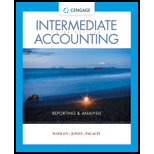
Ascertain the following ratios of Company B:
- 1. Earnings per share.
- 2. Gross profit margin.
- 3. Operating profit margin.
- 4. Net profit margin.
- 5. Total assets turnover ratio.
- 6. Return on assets ratio.
- 7. Return on common equity.
- 8. Receivables turnover ratio.
- 9. Interest coverage.
Explanation of Solution
Earnings per share (EPS): The amount of net income available to each shareholder per common share outstanding is referred to as earnings per share (EPS).
Gross margin (gross profit): Gross margin is the amount of revenue earned from goods sold over the costs incurred for the goods sold.
Net margin: This ratio gauges the operating profitability by quantifying the amount of income earned from business operations from the sales generated.
Asset turnover ratio:
The Asset turnover is a contrast to the profit margin ratio and it is calculated to determine the net sales and average total assets. Use the following formula to calculate the asset turnover ratio:
Return on assets:
Return on assets is the ratio of the net income, and interest expense to the average total assets. The
Accounts receivable turnover is a liquidity measure of accounts receivable in times, which is calculated by dividing the net credit sales by the average amount of net accounts receivables. In simple, it indicates the number of times the average amount of net accounts receivables has been collected during a particular period.
Average collection period:
Average collection period indicates the number of days taken by a business to collect its outstanding amount of accounts receivable on an average. It is otherwise known as days to collect.
Compute the ratio as follows:
- 1. Calculate the earnings per share of Company B:
- 2. Calculate the gross profit margin of company B:
- 3. Calculate the operating profit margin of company B:
- 4. Calculate the net profit margin of company B:
- 5. Calculate the total asset turnover ratio of Company B:
Working note (1):
Calculate the value of average total assets.
- 6. Calculate the return on total assets of Company B:
Working note (2):
Calculate the value of interest expense.
- 7. Calculate the return on common equity of Company B:
Working note (3):
Calculate the average shareholder’s equity.
- 8. Calculate the receivable turnover of Company B:
Working note (4):
Compute the net credit sales:
Working note (5):
Compute the average net receivable:
- 9. Calculate the interest coverage of Company B:
Want to see more full solutions like this?
Chapter 5 Solutions
Interm.acct.:reporting.(ll)-w/access
- I don't need ai answer general accounting questionarrow_forwardWhat amount of support centre department costs will be allocatedarrow_forwardIronside Inc. paid $560 in dividends and $640 in interest this past year. Common stock increased by $270 and retained earnings decreased by $150. What is the net income for the year? a. $560 b. $390 c. $410 d. $610 HELParrow_forward
- General Accountingarrow_forwardEverett Corporation, a company that produces and sells a single product, has provided its contribution format income statement for October: Sales (8,200 units): $452,600 • Variable expenses: $280,200 • Contribution margin: $172,400 Fixed expenses: $115,750 • Net operating income: $56,650 If Everett Corporation sells 9,000 units instead of 8,200 units, what will be its net operating income? A. $69,250 B. $73,800 C. $76,300 D. $80,400arrow_forwardEagle Parts Co. uses direct labor hours in its predetermined overhead rate. At the beginning of the year, the estimated direct labor hours were 13,000 hours, and the total estimated manufacturing overhead was $315,000. At the end of the year, actual direct labor hours were 12,600 hours, and actual manufacturing overhead was $309,000. Find overhead at the end of the year. Helparrow_forward
- General accountingarrow_forwardWhat it likely to be the price of the stock? General accountingarrow_forwardAt the beginning of the year, Averra Corp's liabilities were $120,000. During the year, assets increased by $95,000, and at the end of the year, assets totaled $310,000. Liabilities decreased by $40,000 during the year. Calculate the amount of equity at the end of the year.arrow_forward
 Intermediate Accounting: Reporting And AnalysisAccountingISBN:9781337788281Author:James M. Wahlen, Jefferson P. Jones, Donald PagachPublisher:Cengage Learning
Intermediate Accounting: Reporting And AnalysisAccountingISBN:9781337788281Author:James M. Wahlen, Jefferson P. Jones, Donald PagachPublisher:Cengage Learning Cornerstones of Financial AccountingAccountingISBN:9781337690881Author:Jay Rich, Jeff JonesPublisher:Cengage Learning
Cornerstones of Financial AccountingAccountingISBN:9781337690881Author:Jay Rich, Jeff JonesPublisher:Cengage Learning Managerial Accounting: The Cornerstone of Busines...AccountingISBN:9781337115773Author:Maryanne M. Mowen, Don R. Hansen, Dan L. HeitgerPublisher:Cengage Learning
Managerial Accounting: The Cornerstone of Busines...AccountingISBN:9781337115773Author:Maryanne M. Mowen, Don R. Hansen, Dan L. HeitgerPublisher:Cengage Learning Managerial AccountingAccountingISBN:9781337912020Author:Carl Warren, Ph.d. Cma William B. TaylerPublisher:South-Western College Pub
Managerial AccountingAccountingISBN:9781337912020Author:Carl Warren, Ph.d. Cma William B. TaylerPublisher:South-Western College Pub Financial And Managerial AccountingAccountingISBN:9781337902663Author:WARREN, Carl S.Publisher:Cengage Learning,
Financial And Managerial AccountingAccountingISBN:9781337902663Author:WARREN, Carl S.Publisher:Cengage Learning, Financial AccountingAccountingISBN:9781337272124Author:Carl Warren, James M. Reeve, Jonathan DuchacPublisher:Cengage Learning
Financial AccountingAccountingISBN:9781337272124Author:Carl Warren, James M. Reeve, Jonathan DuchacPublisher:Cengage Learning





